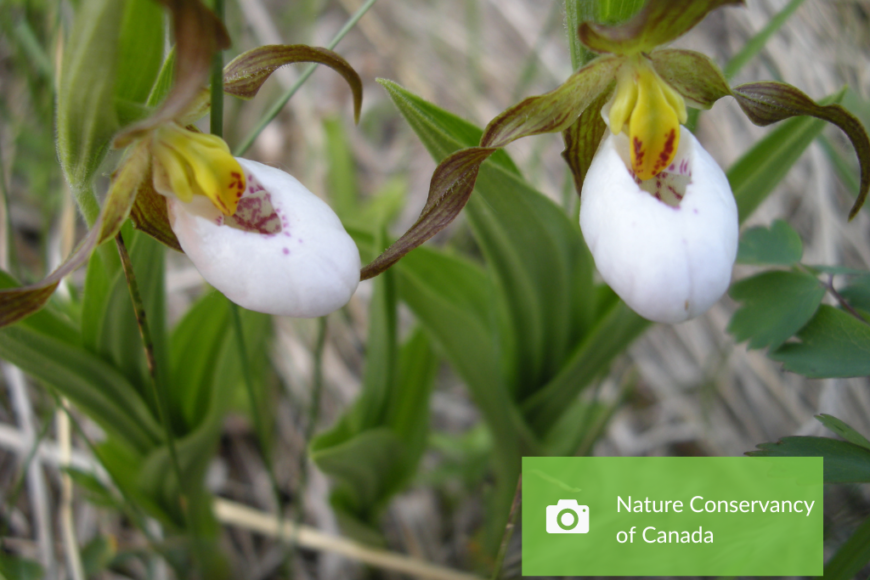Dawson Trail Dispatch, written by Norm Gregoire, July 2024
Page 10 https://issuu.com/dispatch222/docs/dawson_trail_dispatch_july_2024
The summer months in the tall-grass prairie are when this endangered ecosystem is at its best. It seems every few days a new species of wildflower comes into bloom, and native grasses such as big blue stem and prairie cord grass grow taller and taller each day. This is why I recommend that folks visit often during this time; there is so much to discover! During some of the first visits of the season, I have noticed that there is a family of orchids that everyone from grandchildren to grandparents excitedly points out when they first see them: “lady’s-slipper!” Such a unique-looking flower is hard to ignore. A species at risk, the small white lady’s-slipper, is part of that eye catching family.
Small white lady’s-slipper is a perennial orchid that grows 10–35 cm tall. The slipper-shaped flower, which blooms from May through June, is white in colour with light purple veins. A single plant can have between 3 and 60 stems, with each stem surrounded by 2-4 leaves and a single, sometimes double, flower. Hybridization with yellow lady’s-slipper may occur, making identification challenging.
The unique shape of the flower is what catches the eyes of admirers of this species, but onlookers may not realize just how special the orchid is. The shape has adapted to act as a temporary trap for visiting pollinators, ensuring that they move past reproductive parts and promoting cross-pollination when visiting another small white lady’s-slipper. Researchers have witnessed a pollinator take over 15 minutes to find its way out of the flower. What’s harsh is that this pollinator did not even get the reward of nectar from the flower. Small white lady’s-slipper are considered false pollinators and do not give out these rewards. This is a form of deceptive pollination where the flowers falsely advertise a reward to trick the pollinators into paying a visit. A final noteworthy fact about small white lady’s-slipper is that they may take as much as 16 years to bloom! The complexities of this species at risk are incredible.
Small white lady’s-slipper grow in soil that is moist and rich in calcium. They are generally found in open areas that are impacted by natural disturbances such as wildfires and light grazing. When these disturbances do not occur, the small white lady’s-slipper can be negatively affected by woody plant encroachment. Approximately 80% of the known grow sites for small white lady’s-slipper in Manitoba occur near roadways; therefore, the activities involved in maintaining these areas may pose a risk for the species.
Unfortunately, growing near roadways also allows for easier access for illegal harvesting. The admiration of lady’s-slipper makes it a common target for folks who want to add it to their backyard flowerbed. What might not be known is that the lady’s-slipper requires a specific soil fungus to germinate, so when moved, an imbalance in soil composition would ultimately spell doom for the orchid.
These unique orchids depend on wild areas like the tall-grass prairie as their last stronghold. In Manitoba, we are fortunate to share a home with many amazing species, and the small white lady’s-slipper is one that I hope we’ll be able to enjoy for years to come.
Adventures with Nature Norm
A great feature of visiting the tall-grass prairie as an orchid enthusiast is that from May to September, there is always an orchid species in bloom. Although the small white lady’s-slipper season is coming to an end, by joining the July 6th edition of Adventures with Nature Norm, you’ll be able to see western prairie fringed orchids in full bloom! These orchids are found nowhere else in Canada! For more information on this event or any orchid-related questions, please reach out to info@sharedlegacymb.ca.

